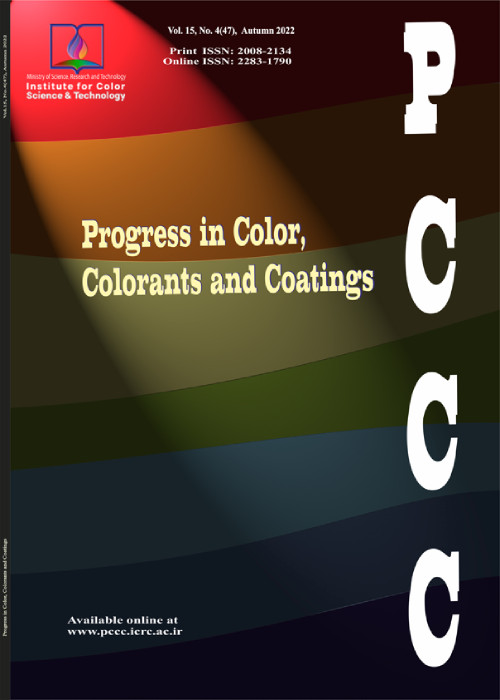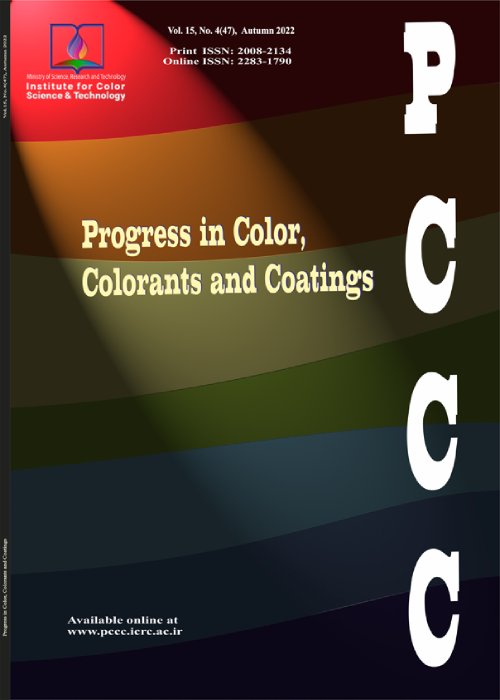فهرست مطالب

Progress in Color, Colorants and Coatings
Volume:17 Issue: 1, Winter 2024
- تاریخ انتشار: 1402/11/12
- تعداد عناوین: 8
-
-
Pages 1-10
Acombined experimental and theoretical study investigated the corrosion inhibition potential of 2-dimethylaminopropionamidoanti-pyrine (DMAPAAP) on mild steel in 1 M hydrochloric acid (HCl) solution. The weight loss method was used to determine the corrosion rate of mild steel in HCl solution both in the absence and presence of different concentrations of DMAPAAP. The effect of exposure time and temperature on the corrosion inhibition efficiency of DMAPAAP was also investigated. The results showed that DMAPAAP exhibited good inhibitory properties against the corrosion of mild steel in an HCl solution. The corrosion rate of mild steel increased with increasing inhibitor concentration, exposure time, and temperature. The highest inhibition efficiency of 91.9 % was achieved at 5 mM concentration of DMAPAAP after 5 hours of exposure time at 333 K. Density functional theory (DFT) calculations were carried out to support the experimental results and understand the inhibition process's mechanism. The adsorption of DMAPAAP on the mild steel surface was found to be both chemisorption and physisorption and followed the Langmuir adsorption isotherm. The inhibition efficiency increased with increasing electron-donating groups in the molecule, which was attributed to forming a protective film on the metal surface. Overall, the combined experimental and theoretical study provides a deeper understanding of the corrosion inhibition mechanism of DMAPAAP on mild steel in HCl solution and demonstrates its potential as an effective corrosion inhibitor for mild steel in industrial applications.</em>
Keywords: Corrosion inhibition 2, Dimethylaminopropionamido antipyrine (DMAPAAP) Mild steel Hydrochloric acid (HCl) Density, functional theory (DFT) -
Pages 11-25
Taking an industrial standpoint, the recognition of Fe(III) as a heavy metal ion can exert a profound impact on the industry. In this research, we synthesized carbon dots from a novel and local green source by hydrothermal method. Afterwards, characterization tests, like dynamic light scattering, zeta potential sizer, atomic force microscopy, Fourier transform infrared spectroscopy, X-ray powder diffraction, elemental analysis, and transmission electron microscopy have been done. After investigation of physicochemical properties, the proposed novel nanobiosensor based on multicolor carbon dots can detect Fe(III) with ultra-low detection limit compared with other studies. The designed nanobiosensor does not identify other ions, confirming its detection specificity. Besides, this nanobiosensor can detect Fe(III) ion in two different conditions, tap water and cysteine solution as real samples. This accurate and sensitive detection of Fe(III) in different conditions can play an impressive role in industries in the near future.</em>
Keywords: Fe(III) detection Multicolor carbon dots Ultra, low detection limit Nanobiosensors -
Pages 27-38
Nanostructured TiO2</sub> coatings were deposited on NiCrAlY coating by RF magnetron sputtering. NiCrAlY coating was deposited by sprayed-plasma method on the Ni-base superalloy substrate. NiCrAlY layer work as the first protection layer while TiO2</sub> nanocoatings as the second protection layer. Laser surface re-melting for coating layers by Nd-YAG laser was done.</em> Hot corrosion test conducted for substrate after coating with both NiCrAlY and TiO2</sub> nanocoating with and without laser surface remelting. Hot corrosion was tested by using a molten salt of Na2</sub>SO4</sub>–55 %V2</sub>O5</sub> at 800 and 900 °C for 60 hours. The weight change measurements were performed to determine the cyclic hot corrosion kinetics of the coatings at a temperature of 800 and 900 °C. The microstructural features, surface topography, and phase composition were characterized by FE-SEM, EDS, AFM, and XRD. The results of FE-SEM indicate that some porosities, cracks, and unmelted powder can be seen on the surface of samples for plasma spraying and RF sputtering of NiCrAlY coatings. After the laser surface remelting of coatings, it can be observed the absence of porosity and crack with enhanced surface properties</em>. The roughness decreases after laser remelting. Hot corrosion tests indicate that</em> the plasma-sprayed NiCrAlY coating can significantly lower the hot corrosion resistance than coating two layers by nanocoating of TiO2</sub> by RF sputtering with laser remelting. The improvement owing to the formation of extensive amounts of the protective oxide of NiO, Al2</sub>O3</sub>, Cr2</sub>O3</sub>, Y2</sub>O3</sub>, and NiCr2</sub>O4</sub> spinal generated on the surface</em>. </em>
Keywords: MCrAlY coatings TiO2 nanocoating Laser re, melting Plasma spraying RF sputtering Hot corrosion -
Pages 39-52
Multiple microbes can alter a plant's development and agricultural productivity, which has significant implications for the ecosystem and human life. As a result, timely identification, prevention, and prompt treatment are required. Fundamental methods have some drawbacks to plant disease identification like more time-consuming, accuracy, doesn't support multiple plant detection. This paper introduces a hybrid model that uses a random forest classifier combined with the AdaBoost Classifier to classify plant diseases to overcome the above-said drawbacks. So as to individualize normal and abnormal leaves from data sets, the suggested methodology employs the Random Forest with AdaBoost algorithm. The operational processes in our suggested study are preprocessing, segmentation, feature extraction, training the classifier, and classification. The produced datasets of infected and uninfected leaves are combined and processed using the Random Forest classifier to categorize the infected and uninfected photos. Color Histogram is used to gather features from imagery. KNN, Naive Bayes, and SVM are all used to evaluate our suggested technique.</em>
Keywords: Random forest, Color histogram, Classification, Feature extraction -
Pages 53-60
The non-context-based approach is used for the synthesis of spectral reflectance curves of objects with known CIEXYZ tristimulus values. The method introduces two sets of features, i.e., the standard color-matching functions normalised by their sum in each wavelength and a group of two sigmoidal and one Gaussian bases that approximately fit the first set. The assigned spectra for the desired tristimulus colorimetric values are calculated using an additive color-mixing approach. Results of different methodologies are numerically compared in terms of root mean squared error (RMSE), goodness fit coefficient (GFC), and CIELAB color difference values between the actual and synthesised spectra. It is found that the synthesised spectra by the suggested primaries better resemble the actual behaviours of spectral reflectances of natural and synthetic objects in comparison to using three Gaussian primaries. Compared to other context and non-context-based approaches to spectral reconstruction, the suggested method is faster and does not require iterative optimisation. </em>
Keywords: Synthetic reflectance Non, context, based primaries Sigmoidal primaries Gaussian primaries -
Pages 61-74
The corrosion inhibition performance of a novel corrosion inhibitor, 1-aminobenzotriazole drug (1-ABT), was comprehensively evaluated through a range of experimental and computational techniques. The effectiveness of 1-ABT as a corrosion inhibitor was investigated using weight loss measurements, electrochemical methods, scanning electron microscopy (SEM), X-ray photoelectron spectroscopy (XPS), and quantum chemical/molecular dynamics studies. Experimental findings revealed a positive relationship between the inhibition effectiveness of 1-ABT and its concentration, while displaying a negative correlation with temperature. Notably, the highest achieved inhibition efficiency of approximately 98 % was observed at a concentration of 400 ppm. The adsorption behavior of 1-ABT on the metal surface was found to conform to the Langmuir adsorption isotherm, indicating monolayer formation. The thermodynamic analysis further supported the physiochemisorption nature of the adsorption process. XPS analysis and theoretical investigations confirmed the adsorption of 1-ABT molecules onto the steel surface, with the interaction between the N atoms of 1-ABT and the vacant d-orbitals of Fe atoms playing a significant role. SEM examinations provided additional evidence, demonstrating a notable reduction in the corrosion rate in the presence of 1-ABT. These findings contribute to the understanding of the corrosion inhibition mechanisms and highlight the potential of 1-ABT as an effective inhibitor for mitigating corrosion in various applications. </em>
Keywords: Corrosion inhibitor, Mild steel, Drug, Electrochemical examinations, Theoretical study -
Pages 75-84
Deinking waste paper is done in various ways, and research on newer methods is also being done. Traditional deinking methods to remove ink from waste printing papers have a relatively high efficiency compared to contact methods, but in non-contact printing such as electrophotographic printing (LaserJet printers and photocopiers) due to Mixing of the ink with the paper texture during the stabilization of the ink with the help of high heat, the traditional deinking methods are less efficient and it is necessary to use newer methods. In this research, enzymatic deinking of office waste paper was done by a commercial cellulase enzyme in a neutral environment. 15 tests were conducted, and optical and printing properties including the paper were investigated. By measuring the reflection before and after printing and measuring the print density after printing, it was determined that the printability of deinked paper is within the desired range. Eric's number was 128 ppm for sample number 8 and 138 ppm for sample number 12, which has decreased compared to the control sample with an Eric number of 571 ppm. Measuring the reflection before and after printing and measuring the print density after printing, show that the printability of decomposed ink paper is in the desired range. </em>
Keywords: Electrophotography, Enzyme deinking, Paper recycling, Printability, Optical properties -
Pages 85-96
Corrosion, the relentless foe plaguing industries exposed to hydrochloric acid solutions, threatens material integrity and equipment longevity. To triumph over this formidable adversary, the development of effective corrosion inhibitors is paramount. In this groundbreaking research, we delve into the untapped potential of 4-Acetamidoantipyrine as a corrosion inhibitor for safeguarding mild steel in hydrochloric acid solutions. Through rigorous experimentation, employing weight loss measurements, adsorption studies, and state-of-the-art computational analysis, we unlock the secrets of this remarkable inhibitor's inhibitory mechanisms. The results astoundingly reveal a pronounced decline in the corrosion rate of mild steel as the concentration of 4-acetamidoantipyrine intensifies. At an impressive concentration of 500 ppm, the inhibitor unleashes its full might, exhibiting an awe-inspiring maximum inhibition efficiency of 91.1 %. Further investigation uncovers the formation of a robust monolayer on the surface of mild steel, meticulously adhering to the revered Langmuir adsorption isotherm. Illuminating the binding mechanism, computational analysis highlights the intricate interaction between the inhibitor's nitrogen and oxygen atoms from the pyrazole and amide groups with the metal surface. These revelatory findings underscore the immense potential of 4-Acetamidoantipyrine as an unparalleled corrosion inhibitor, championing the protection of mild steel in the most aggressive hydrochloric acid environments. Moreover, they provide invaluable insights into the enigmatic inhibitory mechanisms employed by this remarkable compound. By shedding light on the captivating interactions and absorption behavior of 4-acetamidoantipyrine, this seminal study pioneers the advancement of corrosion inhibitors, paving the way for continued exploration and transformative breakthroughs in this captivating field. </em>
Keywords: Corrosion conqueror High, performing inhibitor Mild steel savior Hydrochloric acid defender Revolutionary breakthrough


